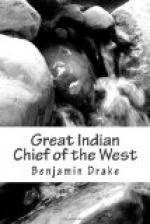he was well received. Upon his next visit to
this Spanish dignitary, he found many sad and gloomy
faces, because the United States were about to take
possession of the town and country around it.
“Soon after the Americans arrived,” says
Black Hawk, “I took my band and went to take
leave, for the last time, of our father. The
Americans came to see him also. Seeing them approach,
we passed out at one door, as they entered at another—and
immediately started, in our canoes, for our village
on Rock river—not liking the change any
more than our friends appeared to at St. Louis.
On arriving at our village, we gave the news that strange
people had taken St. Louis, and that we should never
see our Spanish father again. This information
made all our people sorry. Sometime afterwards
(1805) a boat came up the river with a young American
chief (Lieutenant, afterwards General Pike,) and a
small party of soldiers. We heard of them, soon
after he had passed Salt river. Some of our young
braves watched him every day, to see what sort of people
he had on board. The boat at length arrived at
Rock river, and the young chief came on shore with
his interpreter—made a speech, and gave
us some presents. We, in return, presented him
with meat and such provisions as we could spare.
We were well pleased with the speech of the young chief.
He gave us good advice; said our American father would
treat us well. He presented us an American flag,
which was hoisted. He then requested us to pull
down our British flags, and give him our British medals—promising
to send us others on his return to St. Louis.
This we declined as we wished to have
two fathers.”
Subsequently to this period, the building of Fort
Edwards, near the head of the Des Moyens rapids, gave
much uneasiness to the Sacs. Some of the chiefs
and a party of their followers went down to this point,
and had an interview with the war chief who had command
of the troops engaged in constructing the fort.
The Indians became satisfied and returned home.
Not long afterwards a party, of which Black Hawk was
one, determined to attack and take Fort Madison, standing
upon the west side of the Mississippi, above the mouth
of the Des Moyens, which was then garrisoned with
about fifty men. Their spies having ascertained
that the troops marched out of the fort every morning
to exercise, they concealed themselves near it, with
an agreement to fire upon them when they came out.
About sun rise, on the morning of the proposed attack,
the gate opened, and a young man made his appearance,
but was suffered to return without being molested.
The gate was again opened and four soldiers came out.
They were followed by a fifth, who was instantly killed.
The others then ran for the fort, but two of them
were shot down before they reached it. The Indians
continued for two days, shooting into the fort, and
endeavoring to set fire to it. Finding their efforts
unavailing, they gave up the attack and returned home.




